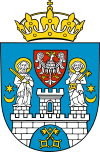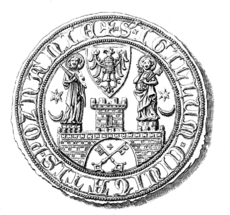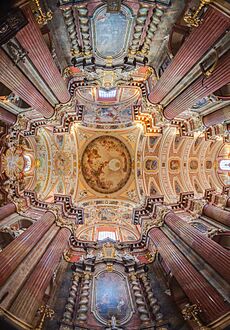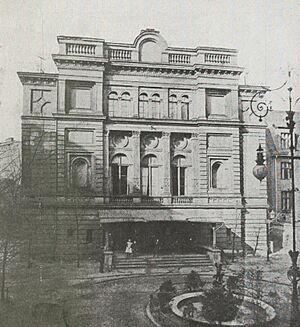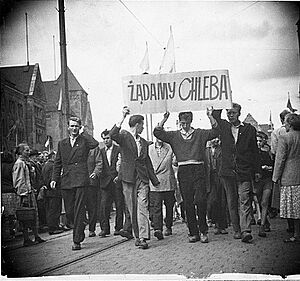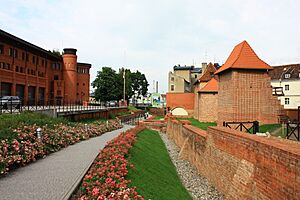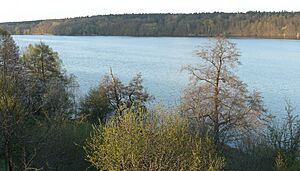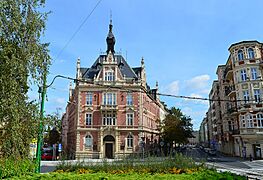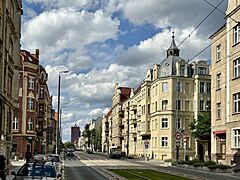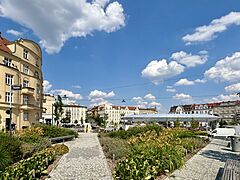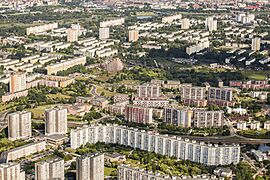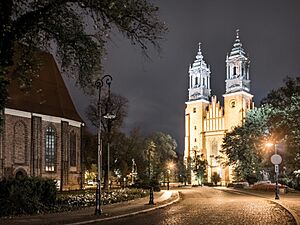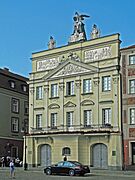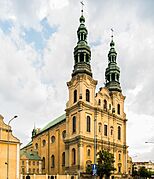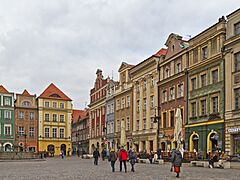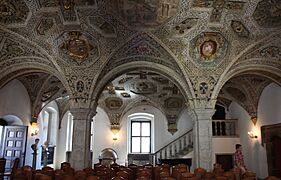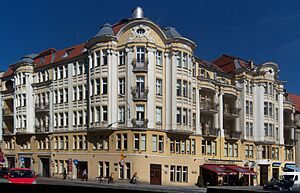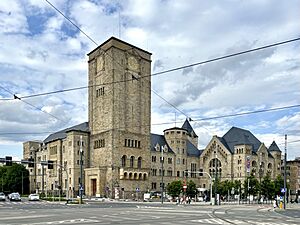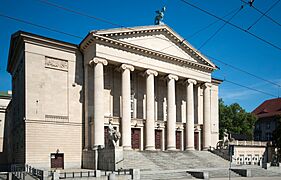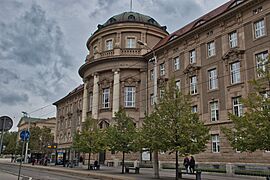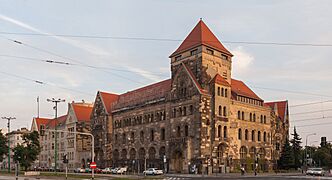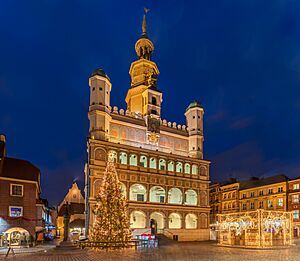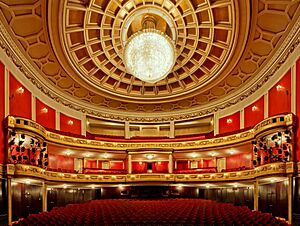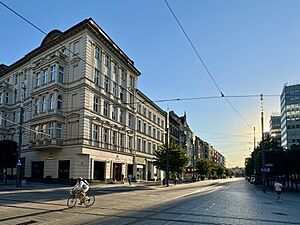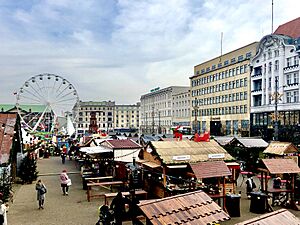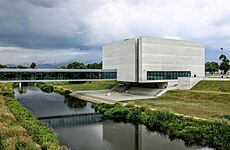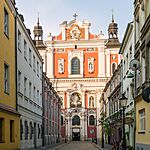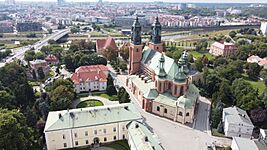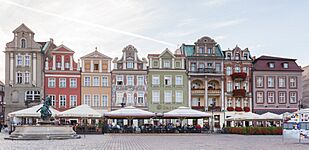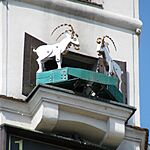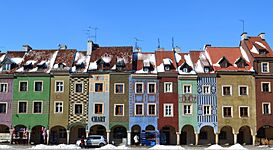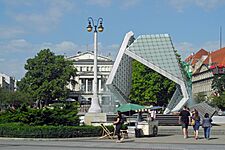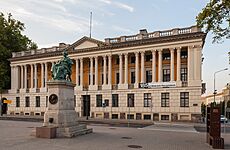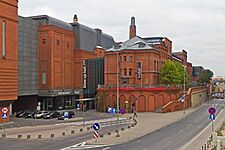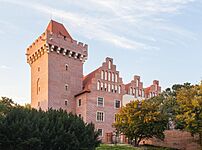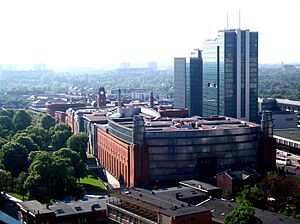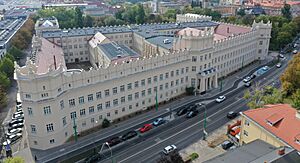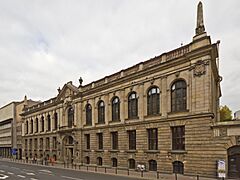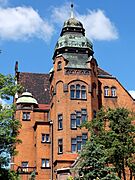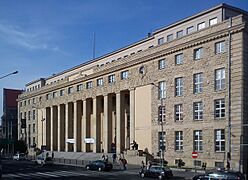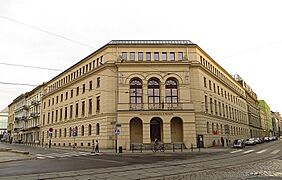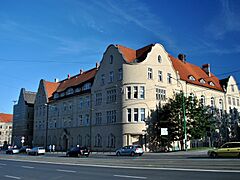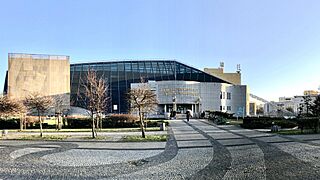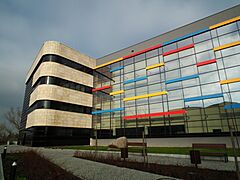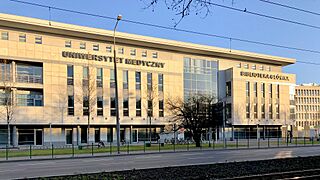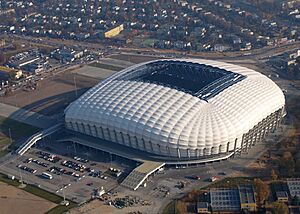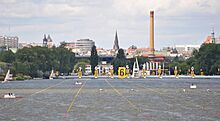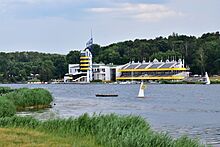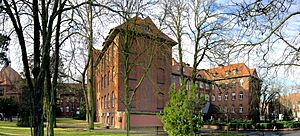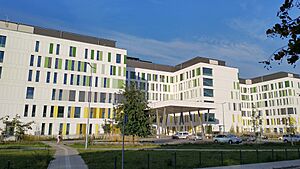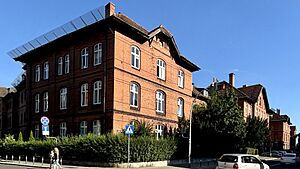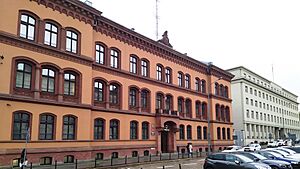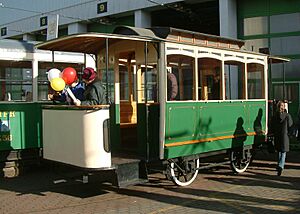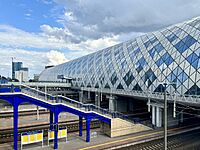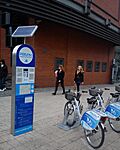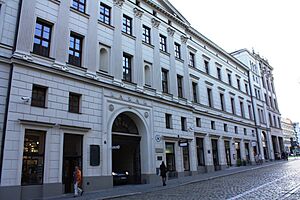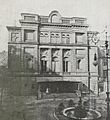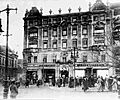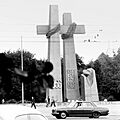Poznań facts for kids
Quick facts for kids
Poznań
|
|||||
|---|---|---|---|---|---|
| Capital City of Poznań Polish: Stołeczne Miasto Poznań |
|||||
|
Part of Old Town with Old Market Square
Imperial Castle
Grand Theatre
Cathedral
Town Hall
New Bałtyk
Fara
Adam Mickiewicz University
|
|||||
|
|||||
| Country | |||||
| Voivodeship | Greater Poland | ||||
| County | City county | ||||
| Established | 10th century | ||||
| City rights | 1253 | ||||
| City Hall | Poznań Town Hall | ||||
| Districts | 42 osiedles | ||||
| Government | |||||
| • Body | Poznań City Council | ||||
| Area | |||||
| • City | 261.85 km2 (101.10 sq mi) | ||||
| • Metro | 2,162 km2 (835 sq mi) | ||||
| Highest elevation | 154 m (505 ft) | ||||
| Lowest elevation | 60 m (200 ft) | ||||
| Population
(30 June 2023)
|
|||||
| • City | 540,146 (5th) | ||||
| • Density | 2,063/km2 (5,340/sq mi) | ||||
| • Metro | 1,029,021 | ||||
| GDP | |||||
| • City | €14.965 billion (2020) | ||||
| • Metro | €28.603 billion (2021) | ||||
| Time zone | UTC+1 (CET) | ||||
| • Summer (DST) | UTC+2 (CEST) | ||||
| Postal code |
60-001 to 61–890
|
||||
| Area code(s) | +48 61 | ||||
| Vehicle registration | PO, PY | ||||
| Website | www.poznan.pl | ||||
Poznań is a vibrant city in western Poland, located on the River Warta. It is a major center for culture and business. Poznań is known for its unique local traditions. These include the Saint John's Fair and delicious Saint Martin's croissants.
Poznań is one of Poland's oldest and largest cities. In 2023, about 540,146 people lived here. The wider Poznań area, including nearby towns, has over 1 million residents. It was once a capital of medieval Poland. Today, it is the main city of the Greater Poland Voivodeship region.
The city is a hub for trade, sports, education, and tourism. It has many universities, with about 130,000 students. Adam Mickiewicz University is one of the biggest in Poland. Poznań also hosts the Poznań International Fair. This is the largest industrial fair in Poland and one of Europe's biggest. Important landmarks include the National Museum, Grand Theatre, and the Imperial Castle.
Poznań is considered a global city. It is known as one of the best cities in Poland for business. It also ranks high for safety and good healthcare. The city has won awards for its high-quality city brand. Famous companies like Enea (energy) and Allegro (e-commerce) are based here.
The official patron saints of Poznań are Saint Peter and Paul of Tarsus. Martin of Tours is also seen as a patron saint.
Contents
- Understanding the Name of Poznań
- A Look at Poznań's History
- Poznań's Location and Natural Features
- How Poznań is Governed
- Amazing Architecture in Poznań
- Culture and Heritage in Poznań
- Poznań's Economy and Business
- Population of Poznań
- Education and Science in Poznań
- Sports in Poznań
- Public Services in Poznań
- Transportation in Poznań
- Poznań's International Connections
- Images for kids
- See also
Understanding the Name of Poznań
The name Poznań likely comes from a person's name, Poznan. This name means "one who is known" or "recognized" in Polish. So, Poznań could mean "Poznan's town" or simply "known town".
The earliest mentions of the city are from the early 1000s. Documents from the 1200s also use names like Posnania or Poznania.
The city's full official name is Stołeczne Miasto Poznań. This means "The Capital City of Poznań". It refers to its important role in the early Polish state. In German, the city is called Posen.
A Look at Poznań's History
Poznań has a long and interesting history, going back many centuries.
Early Beginnings of Poznań
Before Poland became a Christian nation, Poznań was a key center for the Western Polans people. It had a strong fortress between the Warta and Cybina rivers. This area is now called Ostrów Tumski.
Mieszko I, the first known ruler of Poland, built one of his main homes in Poznań. It is believed that Mieszko's baptism in AD 966, which started the Christianization of Poland, might have happened in Poznań.
Poznań from the 11th to 16th Centuries
After Mieszko's baptism, work began on Poznań's cathedral. This was the first cathedral in Poland. Early Polish kings, including Mieszko I and Bolesław I the Brave, were buried here.
In 1038, Poznań was attacked and destroyed by Duke Bretislaus I of Bohemia. Poland was later reunited, but the capital moved to Kraków. In 1138, Poland was divided into smaller duchies. Poznań became part of the Duchy of Greater Poland.
Around 1249, Duke Przemysł I started building the Royal Castle. In 1253, Poznań was officially founded as a town under Magdeburg law. This meant it had special rights and was built with a defensive wall. The city became a place where Polish culture and writing could grow.
Poznań grew in importance during the Jagiellonian period. This was because it was on important trade routes. However, fires and floods often damaged the city. In 1536, a big fire destroyed many buildings, including the castle and town hall.
In 1519, the Lubrański Academy was founded in Poznań. It was a place for higher learning. Later, the Jesuits' college, founded in 1571, was allowed to give degrees.
Poznań in the 17th and 18th Centuries
The 17th and 18th centuries were difficult for Poznań. The city suffered from many wars, military takeovers, and destruction. It was also hit by frequent outbreaks of plague and floods. The population dropped a lot.
In 1793, Poznań came under the control of the Kingdom of Prussia. It became part of the province of South Prussia.
Poznań from the 19th Century to World War I
The Prussian authorities expanded the city's boundaries. They tore down the old city walls in the early 1800s. New streets and buildings were constructed to the west of the old city.
In 1806, Polish soldiers helped Napoleon remove Prussian forces. Poznań became part of the Duchy of Warsaw in 1807. But in 1815, it returned to Prussia. It became the capital of the Grand Duchy of Posen.


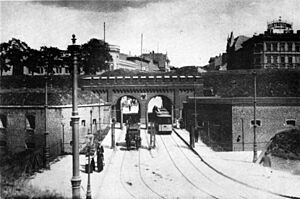
The city continued to grow. Polish people funded projects like the Raczyński Library. The first railway opened in 1848. The Prussians also built a ring of defensive forts around the city, known as Festung Posen.
A Polish uprising in 1848 was not successful. Poznań then became just the capital of the Prussian Province of Posen. It joined the German Empire in 1871. The authorities tried to make the region more German. However, Polish people continued to form societies and promote their culture. The Polish Theatre opened in 1875.
By the early 1900s, the inner forts were mostly taken down. This made space for new buildings, like the Prussian Royal Residence Palace. The city's boundaries were also greatly expanded. In 1910, nearly 60% of Poznań's inhabitants were Poles.
Poznań Between the World Wars
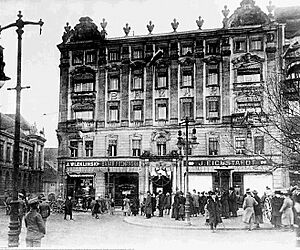
After World War I, the Greater Poland Uprising brought Poznań back to newly independent Poland. Many German residents moved out.
In the time between the two World Wars, Poznań became the capital of Poznań Voivodeship again. Adam Mickiewicz University was founded in 1919. The Poznań International Fair started in 1924. In 1929, a huge National Exhibition was held, attracting millions of visitors. The city's boundaries were expanded again in 1925 and 1933.
Poznań During World War II
During the German occupation from 1939 to 1945, Poznań was made part of Nazi Germany. Many Polish people were arrested, forced to leave, or used as forced labor. Polish children were also taken and sent to a camp in Łódź. At the same time, many Germans moved into the city.
A concentration camp was set up in Fort VII. The Jewish community, which had been in the city since the 1200s, was almost entirely destroyed during the Holocaust.
The Polish resistance was active in Poznań. The city was captured by the Red Army in February 1945, after a fierce battle. Much of the city, especially the Old Town, was left in ruins.
Poznań from 1945 to Today
After the war, most German residents left. Poznań's population became almost entirely Polish. The city became a voivodeship capital again.
In June 1956, workers in Poznań protested against the communist government. This led to strikes and clashes. Many people were killed. A monument was built in 1981 to remember the victims.
After the war, many damaged buildings were rebuilt. From the 1960s, new apartment blocks were built. The Warta river's course was changed in 1968 to help prevent floods.
The city's boundaries were last expanded in 1987. After the fall of communism in 1989, the first free local elections were held in 1990. Poznań became the capital of the larger Greater Poland Voivodeship in 1999.
Modern developments include the Pestka Fast Tram in 1997. The A2 motorway opened in 2003, connecting Poznań to other major cities. In 2006, F-16 Fighting Falcons fighter jets were stationed near the city.
Poznań continues to host trade fairs and international events. It was one of the host cities for the UEFA Euro 2012 football championship.
Poznań's Location and Natural Features
Poznań covers an area of about 261.3 square kilometers. Its highest point is Morasko hill, at 157 meters above sea level. The lowest point is 60 meters, in the Warta river valley.
The Warta River and Lakes
Poznań's main river is the Warta. It flows through the city from south to north. Near the city center, it splits around Ostrów Tumski island. The smaller Cybina river also joins the Warta. The Warta's course in the city center has been changed over time to prevent floods.
The largest lake in Poznań is Kiekrz in the northwest. Other big lakes include Malta, an artificial lake on the Cybina river, and Strzeszyn and Rusałka on the Bogdanka river. Strzeszyn and Rusałka are popular for swimming. Kiekrz lake is great for sailing, while Malta is used for rowing and canoeing competitions.
City Layout
The city center, including the Old Town and main street Święty Marcin, is on the west side of the Warta. Ostrów Tumski island, with the Cathedral, is between the two branches of the Warta. The historic district of Śródka is on the east bank.
Large areas of apartment blocks were built from the 1960s onwards. These include Rataje in the east, and Winogrady and Piątkowo in the north. Older neighborhoods include Wilda, Łazarz, Górczyn, and Jeżyce. There are also large forest areas within the city.
- Districts of Poznań
Poznań's Climate
Poznań has a climate with relatively cold winters and warm summers. Snow is common in winter, and temperatures often drop below freezing at night. In summer, temperatures can reach 30°C (86°F).
The city gets over 500 mm (20 inches) of rain each year. July is the rainiest month, mostly due to short, strong thunderstorms. Poznań also gets a lot of sunshine compared to other parts of Poland.
How Poznań is Governed
Poznań is divided into 42 neighborhoods called osiedle. Each neighborhood has its own elected council. These councils have some power to make decisions and spend money.
For some official purposes, the city still uses an older division into five main districts. These are:
- Stare Miasto (Old Town)
- Nowe Miasto (New Town)
- Grunwald
- Jeżyce
- Wilda
Many people have moved from Poznań to its suburbs in recent decades. This is because of the city's strong economy and good job opportunities. The Poznań metropolitan area, including these suburbs, has over 1 million residents.
Amazing Architecture in Poznań
Poznań has many beautiful buildings from different time periods.
Gothic Buildings
When Poznań moved to the left bank of the Warta River in the 1200s, many Gothic buildings were constructed. This style was popular from the mid-1200s to the late 1400s.
Important Gothic sites on the older, right bank include:
- Church of the Blessed Virgin Mary: Built on the site of an old chapel from around 965.
- Church of Saint John of Jerusalem outside the walls: One of Poland's earliest brick churches, built by the Knights Hospitaller.
- Church of St. Margaret: Dates from the late 1100s.
- Archcathedral Basilica of St. Peter and St. Paul: This 14th-century cathedral has been rebuilt many times.
On the left bank, you can find:
- Church of St. Adalbert: A church on St. Adalbert's Hill.
- Church of Our Lady Help of Christians: Features unique Gothic vaults.
- Church of the Sacred Heart of Jesus and Our Lady of Consolation: The oldest church still standing on the left bank.
- Church of St. Martin: Likely built by Duke Przemysł I in 1240.
- Church of Corpus Christi: The largest Gothic church in Poznań after the cathedral.
Renaissance and Baroque Styles
The Renaissance and Baroque architecture brought many grand buildings to Poznań. The Town Hall is a great example of Renaissance style in Poland. It was rebuilt after a fire in 1536 by Giovanni Battista Quadro. He added a third floor and a beautiful facade with three towers. The central tower has the famous Poznań goats, which appear every day at noon.
From the Baroque period, the Poznań Fara (Collegiate Basilica) is one of the most important Baroque buildings in Poland. Its construction began in the mid-1600s.
- Baroque and renaissance in Poznań
Art Nouveau Buildings
In the early 1900s, Poznań expanded. This allowed for new buildings and neighborhoods. Many new homes and complexes were built.
One example is the Johow-Gelände in the Łazarz district. These houses had front gardens and richly decorated entrances. Many Art Nouveau buildings can also be found on nearby streets like Matejki and Wyspiańskiego.
The Jeżyce district also saw many new homes. The New Theatre, built in 1906, shows the Art Nouveau style of the German region. You can see similar architecture in central Jeżyce.
The Imperial District
The Imperial District was built in the early 1900s as a grand area of Poznań. Emperor Wilhelm II decided to change Poznań from a fortress city to a residential one. A plan for a new district was created in 1903 and built between 1904 and 1910.
The main building in this district is the Imperial Castle. It was built for Wilhelm II. Today, it is a cultural center with a cinema, concert hall, and exhibition spaces.
Adam Mickiewicz Square is at the heart of the district. It has a monument to the poet and a monument to the victims of the June 1956 protests.
Other important buildings in the Imperial District include:
- The Municipal Theater (now the Grand Theater)
- Collegium Maius
- Collegium Minus
- Music Academy
- Poznań Philharmonic
- Imperial District
Modern and Contemporary Architecture
Modern architecture appeared in Poznań in the 1930s. The Okrąglak, built from 1949 to 1954, is a famous example. It's a nine-story round building with a unique glass facade.
Other modern buildings include the Alfa Towers and the Arena Hall. The Arena Hall, built in 1974, was inspired by a similar building in Rome.
Newer buildings, from the 2000s, often combine old and new styles. Bałtyk is a 16-story office tower known for its changing appearance from different angles. Other modern examples are the Porta Posnania and the Andersia office complex.
Stary Browar is a great example of modernizing old buildings. It's a shopping and art center built on the site of a 19th-century brewery. It blends new forms with historical industrial architecture.
Culture and Heritage in Poznań
Poznań has many historic buildings and sites. Most are in the Old Town and city center. Many of these are part of the Poznań Royal-Imperial Route. This route guides visitors through the city's history and culture. Parts of the city center are even listed as official national historic monuments.
Theatres and Music
Poznań has many traditional theaters, like Teatr Wielki (Grand Theatre) and Teatr Polski. There are also many smaller, alternative theater groups. Poznań is becoming a new center for "off-theatre" performances.
Classical music events include the Henryk Wieniawski Violin Competition, held every five years. The Poznań Philharmonic orchestra also holds concerts. The Hall of the Adam Mickiewicz University is known for its great acoustics. The Poznań Nightingales choir is very popular.
Poznań was also an early center for hip-hop and rap music in Poland. Many local rappers are linked to the city's football club, Lech Poznań.
Local Traditions and Festivals
Every year on November 11, Poznań celebrates Day of St. Martin. A procession with Saint Martin parades along Saint Martin Street. During this time, the famous St. Martin's Croissants are sold everywhere.
Since 2000, Poznań has hosted Betlejem Poznańskie, a Christmas event. It features a live nativity scene with real animals. There are also concerts, competitions, and stalls selling crafts and traditional foods. The International Ice Sculpture Festival is held annually during this event.
The annual Malta Festival takes place in late June and early July. It features modern experimental theater, cinema, music, and dance. Poznań also hosts the Ale Kino! International Young Audience Film Festival in December. Other festivals include Animator (animated film), Ethno Port (ethnic music), and the Festival of Ice Sculpture.
Museums and Recreation
Poznań has several museums and cinemas. The Rozbrat social center is a place for independent culture. It hosts concerts, art shows, and has an anarchist library. The city center has many clubs, pubs, and coffee houses.
Malta is a popular park with an artificial lake. On one side, there are ski and sleigh slopes at Malta Ski. On the other side, Termy Maltańskie offers large swimming pools.
The Poznań Zoological Garden has two locations. The Old Zoo is one of the oldest in Poland. The large New Zoo opened in 1974. It is located in a hilly forest area. A mini-railway called Maltanka takes visitors to the New Zoo.
- Places of interest
-
Śródka's Porta Posnania with steel-glass footbridge over small right branch of Warta.
-
Polish Theatre, founded in 1885, the theatre's façade was adorned with the inscription "The Nation Unto Itself" (Polish: Naród sobie)
Poznań's Economy and Business
Poznań has been an important trading center for centuries. In the 1800s, heavy industry grew, with factories like Hipolit Cegielski's steel mill.
Today, Poznań is one of Poland's main trade centers. It is considered the second most successful city in Poland, after Warsaw. Many European companies have their Polish headquarters in Poznań or nearby towns. Most foreign investors are from Germany and the Netherlands.
Companies are attracted by lower labor costs, good transport, and skilled workers. They invest in food processing, furniture, automotive, and logistics industries.
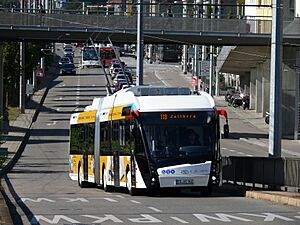
Well-known companies based in Poznań include Allegro, Poland's biggest e-commerce site. H. Cegielski-Poznań SA is a historic manufacturer. Solaris Bus & Coach, a modern bus maker, is based nearby. Enea S.A. is a large energy company. Kompania Piwowarska produces some of Poland's most famous beers.
Stary Browar, a shopping and art center, has won awards for its architecture. Other major shopping centers include Posnania and Galeria Malta.
Population of Poznań
In 1600, about 20,000 people lived in Poznań. By 1732, the population dropped to 4,000 due to wars and diseases. The population grew a lot in the 1800s and 1900s. In 1939, there were 274,155 people.
Since 1990, Poznań's population has slowly decreased. This is partly because many people have moved to the suburbs. In 2020, Poznań had 532,048 residents, making it the fifth most populated city in Poland. The wider metropolitan area has about 1 million people.
Poznań has a high number of foreign residents in Poland. Many are workers from Ukraine. There are also many students from other countries.
Education and Science in Poznań
Poznań is one of Poland's largest academic centers. About 140,000 students study in the city. This means one in four people in Poznań is a student. The city has almost 30 universities and colleges, offering many study options.
Public Universities
Poznań has eight state-owned universities. Adam Mickiewicz University (UAM) is one of the biggest and most important universities in Poland. Poznań University of Technology (PUT) is a leading technical university.
- Adam Mickiewicz University
- Poznań University of Technology
- Poznań University of Economics and Business
- Poznań University of Medical Sciences
- University of Life Sciences in Poznań
- Poznań University School of Physical Education
- University of Fine Arts in Poznań
- Academy of Music in Poznań
Adam Mickiewicz University is considered one of the top three universities in Poland. It has many international students and research projects. The "Morasko Campus" in northern Poznań is a large, modern university campus.
Poznań University of Technology is also highly ranked. In 2019, it was among the top 500 universities worldwide for "Computer Science & Engineering" and "Mechanical Engineering." Its "Warta campus" is located near Lake Malta.
- Higher education institutions in Poznań
Private Universities and High Schools
Poznań also has many smaller, private colleges. These include SWPS University and WSB University.
The city has many high schools with different specializations. Some well-known ones are:
- Adam Mickiewicz High School
- Karol Marcinkowski High School
- St. John Cantius High School
- St. Mary Magdalene High School
Sports in Poznań
Poznań has several sports clubs. Warta Poznań was very successful before World War II. The Lech Poznań football team often plays in European competitions. Lech plays at the Municipal Stadium, which hosted games during the UEFA Euro 2012 championship.
The city's third professional football team, Olimpia Poznań, stopped playing football in 2004. The club now focuses on other sports like judo and tennis. Olimpia hosts the annual Poznań Open tennis tournament.
The artificial Malta lake, about 2.2 km (1.4 miles) long, has hosted major rowing and canoeing championships.
Termy Maltańskie is a large water sports complex on the north bank of Lake Malta. It has an Olympic-size swimming pool and other pools. Some pools use natural geothermal water from deep underground.
On the south bank of the lake, Malta-Ski is a year-round skiing complex. It also has a toboggan run and a minigolf course.
Since 2000, Poznań has hosted the Poznań Marathon, one of Poland's biggest races.
The city's main indoor sports arena is called Arena. It was built in 1974 and can hold about 9,200 people. It hosts many sports and cultural events.
Poznań has the largest motorsport race track in Poland, Tor Poznań, located just outside the city.
Poznań is also a strong center for Polish field hockey. Several top teams, like Warta Poznań and Grunwald Poznań, are based here.
Public Services in Poznań
Healthcare Facilities
Poznań has many healthcare providers. There are municipal hospitals, like the Franciszek Raszeja City Hospital.
In total, there are 20 hospitals in Poznań. These include 5 hospitals managed by the Greater Poland Voivodeship, such as the Greater Poland Oncology Center. There are also 5 clinical hospitals linked to the Poznań University of Medical Sciences, like the Heliodor Święcicki Clinical Hospital. Additionally, Poznań has 10 private hospitals.
Each year, over 300,000 people are treated in Poznań's hospitals. The clinical hospitals of the Medical University handle about 56% of all patients.
Police and City Guard
Various police units work in Poznań to keep people safe. The Voivodship Police Headquarters coordinates police activities across the region. The Municipal Police Headquarters in Poznań is responsible for safety within the city. It oversees several police stations in different districts.
The Municipal Police Headquarters has about 1,800 officers. They also oversee police stations in nearby towns. A National Safety Threat Map helps the police and public communicate to improve safety.
The City Guard (Straż Miejska) works under the City Hall. It has about 300 guards and five district branches.
Poznań also uses a video surveillance system with 395 cameras to help with safety and crime detection. The footage is monitored by staff at police stations and other centers.
Transportation in Poznań
The main railway station in Poznań is Poznań Główny. It is just southwest of the city center. There are also smaller stations and others on the city's outskirts.
The main east–west A2 motorway runs south of the city. It connects Poznań to Berlin in the west and Łódż and Warsaw in the east. Other main roads connect Poznań to cities like Bydgoszcz, Katowice, and Wrocław.
Poznań has an international airport called Poznań-Ławica. It offers flights to many European countries and popular holiday resorts. In 2016, it handled about 1.71 million passengers.
Since 1989, the city has invested a lot in public transport. This includes trams and buses. New tram lines are being built, and older vehicles are being replaced with modern, low-floor trams and buses.
Paid parking zones have been set up in the city center. Park & Ride car parks encourage people to leave their cars outside the center and use public transport. This has helped increase the use of public transport.
Poznań's International Connections
Consulates in Poznań
Poznań hosts a consular agency for the United States and a consulate general for Russia. It also has 21 honorary consulates for countries like Germany, France, Italy, and Japan.
Twin Towns and Sister Cities
Poznań is twinned with many cities around the world. These partnerships help build friendships and cultural exchange. Some of its twin towns include:
 Assen, Netherlands
Assen, Netherlands Brno, Czech Republic
Brno, Czech Republic Kharkiv, Ukraine
Kharkiv, Ukraine Hannover, Germany
Hannover, Germany Jyväskylä, Finland
Jyväskylä, Finland Toledo, Ohio, United States
Toledo, Ohio, United States Rennes, France
Rennes, France Shenzhen, China
Shenzhen, China
Images for kids
-
A lithograph from 1833. In the centre background the former Jesuits' college and Górków Palace on the right.
-
Raczyński Library (1828) on the left seen across the Wilhelmstrasse, now Marcinkowskiego boulevard. Postcard from 1904.
-
As Poznań grew in the 19th century, Berlin Gate (c. 1890, b. 1849), main west gate of the Prussian inner fortification ring, almost immediately began to impede city's development and was torn down in 1901.
-
Successful Greater Poland uprising broke out on 27 December 1918 after a patriotic speech by Ignacy Paderewski at Hotel Bazar, pictured in that period.
See also
 In Spanish: Poznan para niños
In Spanish: Poznan para niños











